Dimensional Fund Advisors (DFA) 2002 HBS Case: Finance Strategies
VerifiedAdded on 2022/11/28
|10
|2448
|446
Case Study
AI Summary
This case study analyzes the Dimensional Fund Advisors (DFA) 2002 HBS case, examining DFA's value proposition for investors, marketing strategies, and the application of Fama-French findings. The analysis covers the replication of the Ken French website, the performance of small stocks, and the relevance of beta. It contrasts Frazzini and Pedersen’s approach with DFA's, assesses market efficiency, and details DFA's trading strategy, risk management, and competitive advantages. The case also explores DFA's tax-managed strategies and their potential for success. The assignment delves into DFA's ability to maintain its edge, the emulability of its strategies by competitors, and the implications of its product development and market positioning. The document examines the trading strategy's effectiveness under various market conditions and its influence on the company's marketing efforts, providing a comprehensive overview of DFA's financial strategies and market dynamics.
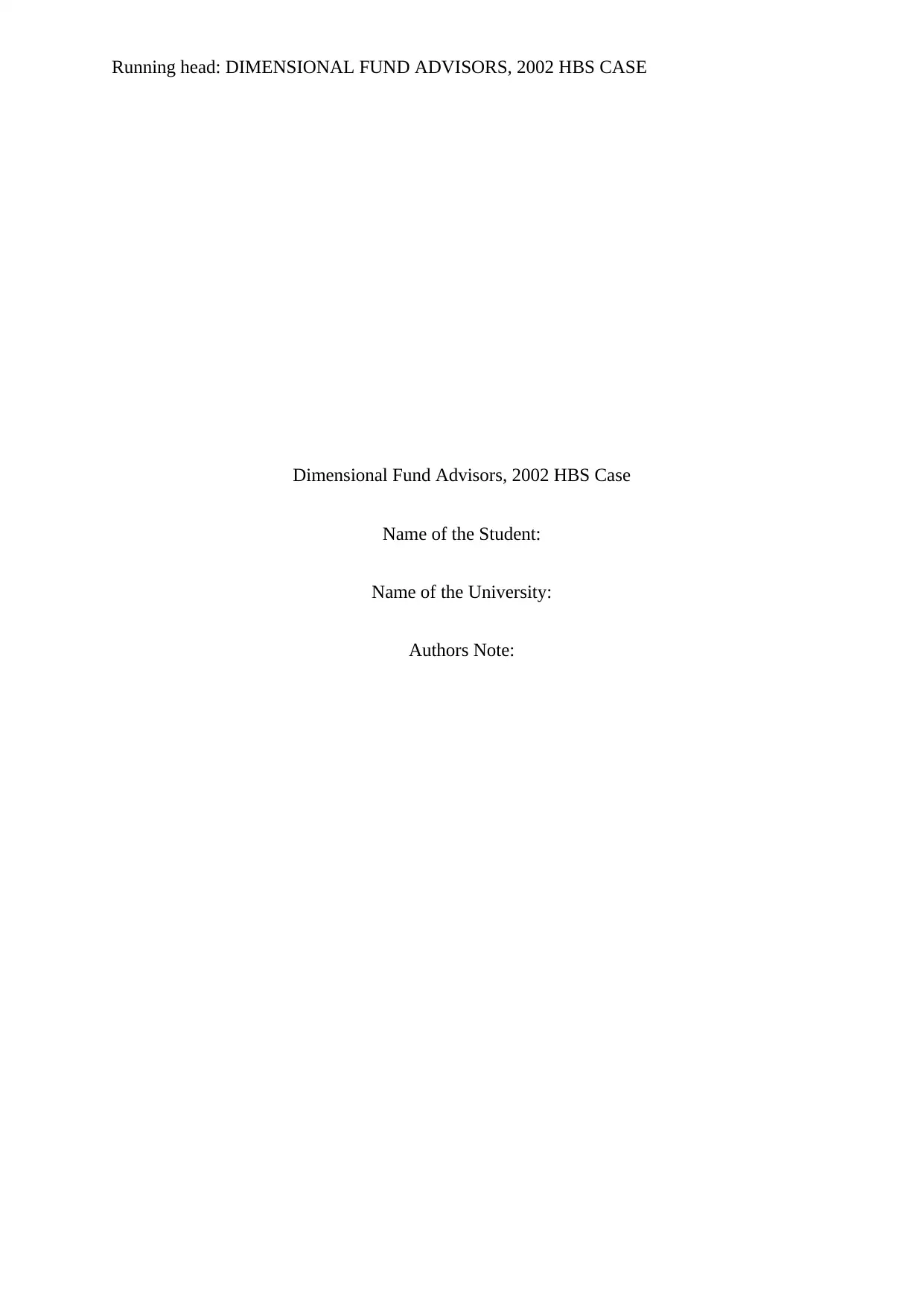
Running head: DIMENSIONAL FUND ADVISORS, 2002 HBS CASE
Dimensional Fund Advisors, 2002 HBS Case
Name of the Student:
Name of the University:
Authors Note:
Dimensional Fund Advisors, 2002 HBS Case
Name of the Student:
Name of the University:
Authors Note:
Paraphrase This Document
Need a fresh take? Get an instant paraphrase of this document with our AI Paraphraser
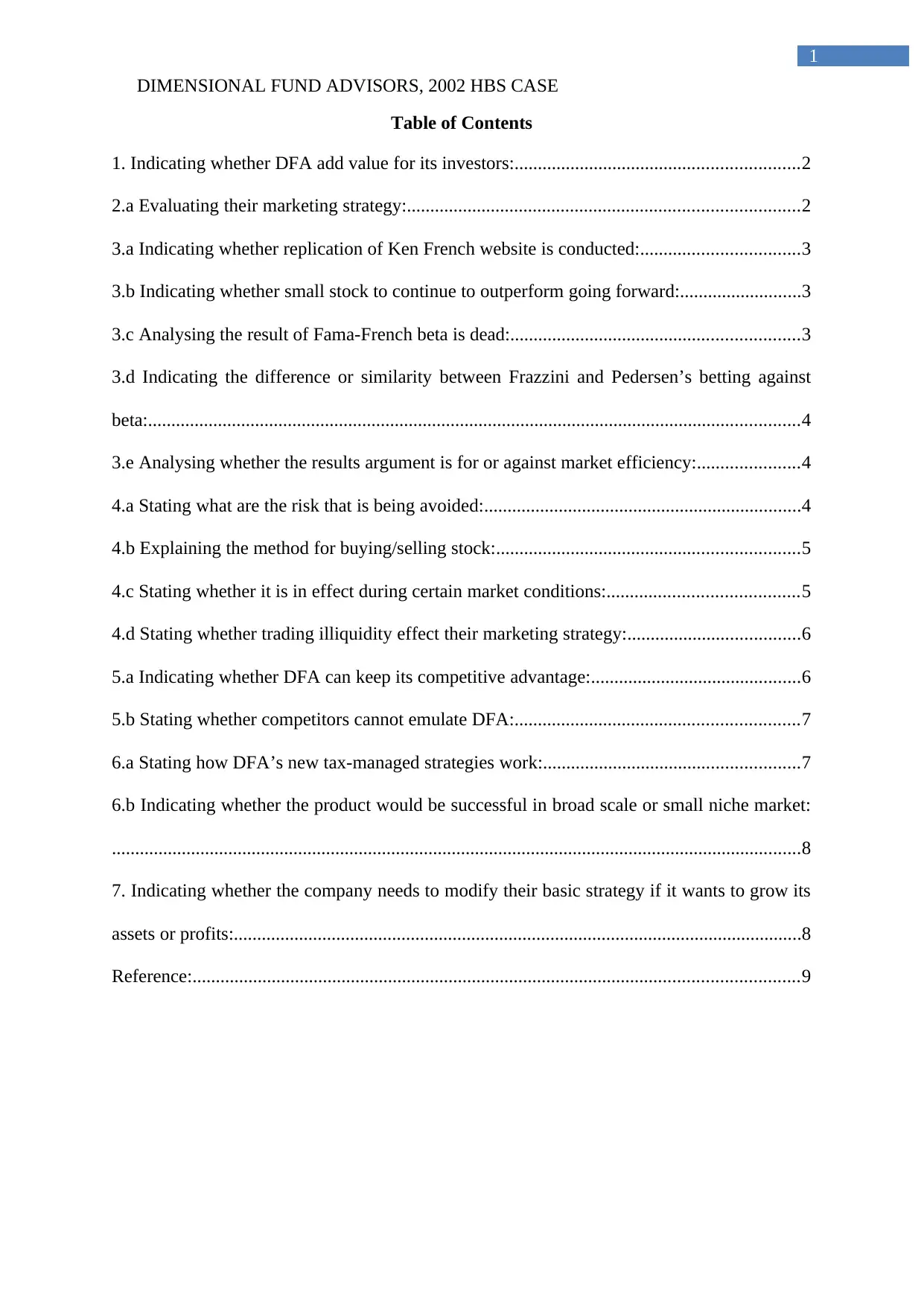
DIMENSIONAL FUND ADVISORS, 2002 HBS CASE
1
Table of Contents
1. Indicating whether DFA add value for its investors:.............................................................2
2.a Evaluating their marketing strategy:....................................................................................2
3.a Indicating whether replication of Ken French website is conducted:..................................3
3.b Indicating whether small stock to continue to outperform going forward:..........................3
3.c Analysing the result of Fama-French beta is dead:..............................................................3
3.d Indicating the difference or similarity between Frazzini and Pedersen’s betting against
beta:............................................................................................................................................4
3.e Analysing whether the results argument is for or against market efficiency:......................4
4.a Stating what are the risk that is being avoided:....................................................................4
4.b Explaining the method for buying/selling stock:.................................................................5
4.c Stating whether it is in effect during certain market conditions:.........................................5
4.d Stating whether trading illiquidity effect their marketing strategy:.....................................6
5.a Indicating whether DFA can keep its competitive advantage:.............................................6
5.b Stating whether competitors cannot emulate DFA:.............................................................7
6.a Stating how DFA’s new tax-managed strategies work:.......................................................7
6.b Indicating whether the product would be successful in broad scale or small niche market:
....................................................................................................................................................8
7. Indicating whether the company needs to modify their basic strategy if it wants to grow its
assets or profits:..........................................................................................................................8
Reference:..................................................................................................................................9
1
Table of Contents
1. Indicating whether DFA add value for its investors:.............................................................2
2.a Evaluating their marketing strategy:....................................................................................2
3.a Indicating whether replication of Ken French website is conducted:..................................3
3.b Indicating whether small stock to continue to outperform going forward:..........................3
3.c Analysing the result of Fama-French beta is dead:..............................................................3
3.d Indicating the difference or similarity between Frazzini and Pedersen’s betting against
beta:............................................................................................................................................4
3.e Analysing whether the results argument is for or against market efficiency:......................4
4.a Stating what are the risk that is being avoided:....................................................................4
4.b Explaining the method for buying/selling stock:.................................................................5
4.c Stating whether it is in effect during certain market conditions:.........................................5
4.d Stating whether trading illiquidity effect their marketing strategy:.....................................6
5.a Indicating whether DFA can keep its competitive advantage:.............................................6
5.b Stating whether competitors cannot emulate DFA:.............................................................7
6.a Stating how DFA’s new tax-managed strategies work:.......................................................7
6.b Indicating whether the product would be successful in broad scale or small niche market:
....................................................................................................................................................8
7. Indicating whether the company needs to modify their basic strategy if it wants to grow its
assets or profits:..........................................................................................................................8
Reference:..................................................................................................................................9
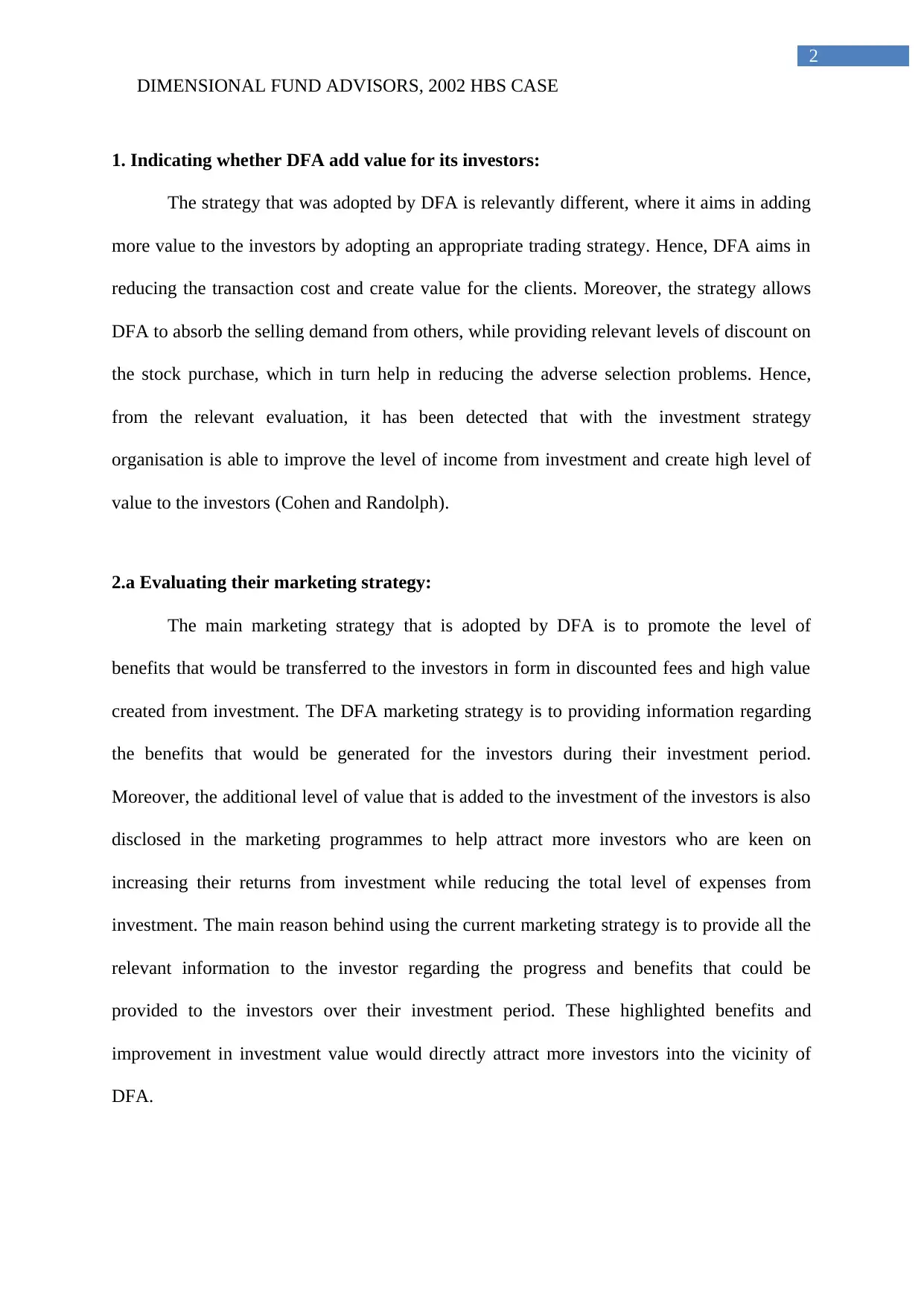
DIMENSIONAL FUND ADVISORS, 2002 HBS CASE
2
1. Indicating whether DFA add value for its investors:
The strategy that was adopted by DFA is relevantly different, where it aims in adding
more value to the investors by adopting an appropriate trading strategy. Hence, DFA aims in
reducing the transaction cost and create value for the clients. Moreover, the strategy allows
DFA to absorb the selling demand from others, while providing relevant levels of discount on
the stock purchase, which in turn help in reducing the adverse selection problems. Hence,
from the relevant evaluation, it has been detected that with the investment strategy
organisation is able to improve the level of income from investment and create high level of
value to the investors (Cohen and Randolph).
2.a Evaluating their marketing strategy:
The main marketing strategy that is adopted by DFA is to promote the level of
benefits that would be transferred to the investors in form in discounted fees and high value
created from investment. The DFA marketing strategy is to providing information regarding
the benefits that would be generated for the investors during their investment period.
Moreover, the additional level of value that is added to the investment of the investors is also
disclosed in the marketing programmes to help attract more investors who are keen on
increasing their returns from investment while reducing the total level of expenses from
investment. The main reason behind using the current marketing strategy is to provide all the
relevant information to the investor regarding the progress and benefits that could be
provided to the investors over their investment period. These highlighted benefits and
improvement in investment value would directly attract more investors into the vicinity of
DFA.
2
1. Indicating whether DFA add value for its investors:
The strategy that was adopted by DFA is relevantly different, where it aims in adding
more value to the investors by adopting an appropriate trading strategy. Hence, DFA aims in
reducing the transaction cost and create value for the clients. Moreover, the strategy allows
DFA to absorb the selling demand from others, while providing relevant levels of discount on
the stock purchase, which in turn help in reducing the adverse selection problems. Hence,
from the relevant evaluation, it has been detected that with the investment strategy
organisation is able to improve the level of income from investment and create high level of
value to the investors (Cohen and Randolph).
2.a Evaluating their marketing strategy:
The main marketing strategy that is adopted by DFA is to promote the level of
benefits that would be transferred to the investors in form in discounted fees and high value
created from investment. The DFA marketing strategy is to providing information regarding
the benefits that would be generated for the investors during their investment period.
Moreover, the additional level of value that is added to the investment of the investors is also
disclosed in the marketing programmes to help attract more investors who are keen on
increasing their returns from investment while reducing the total level of expenses from
investment. The main reason behind using the current marketing strategy is to provide all the
relevant information to the investor regarding the progress and benefits that could be
provided to the investors over their investment period. These highlighted benefits and
improvement in investment value would directly attract more investors into the vicinity of
DFA.
⊘ This is a preview!⊘
Do you want full access?
Subscribe today to unlock all pages.

Trusted by 1+ million students worldwide
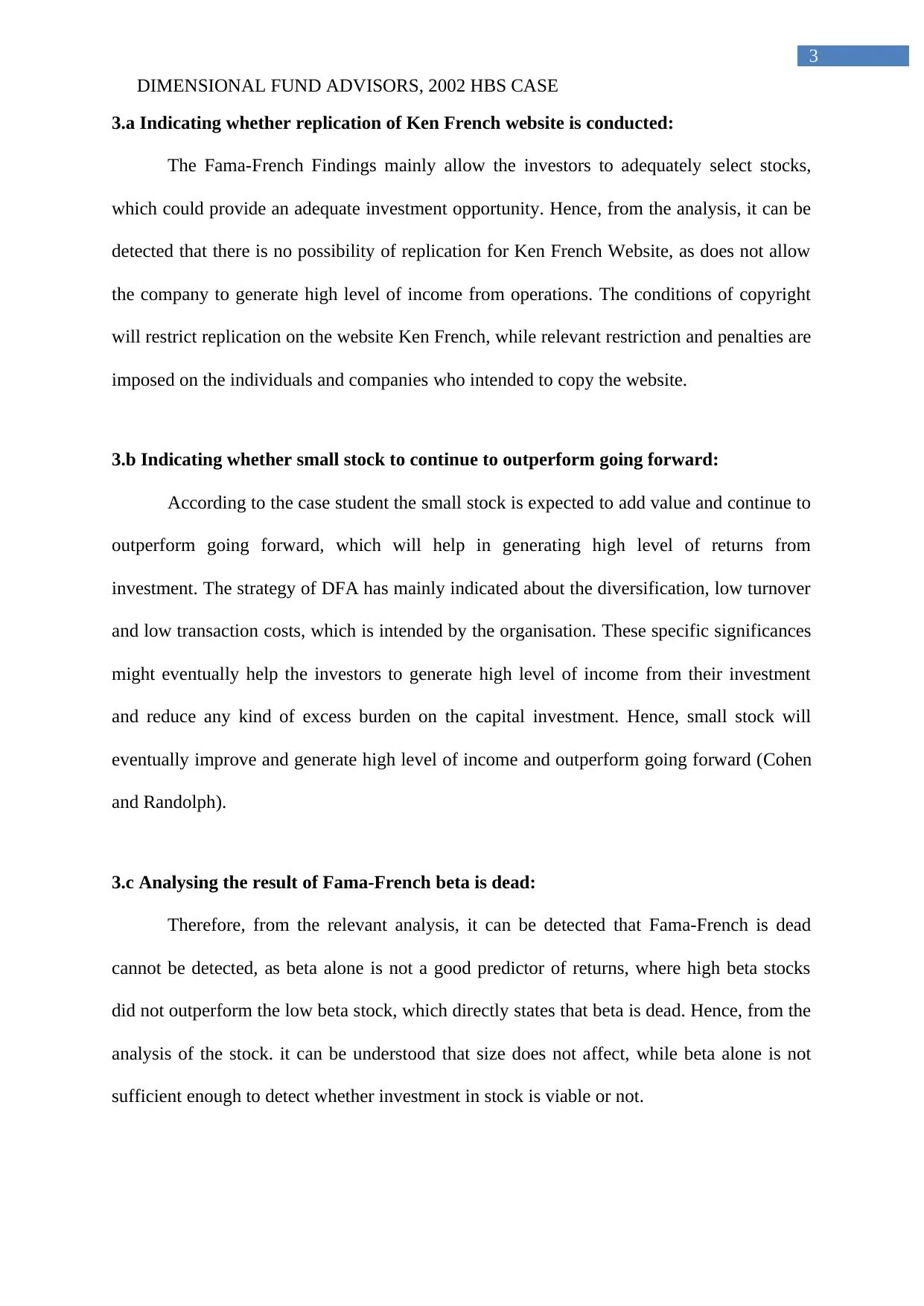
DIMENSIONAL FUND ADVISORS, 2002 HBS CASE
3
3.a Indicating whether replication of Ken French website is conducted:
The Fama-French Findings mainly allow the investors to adequately select stocks,
which could provide an adequate investment opportunity. Hence, from the analysis, it can be
detected that there is no possibility of replication for Ken French Website, as does not allow
the company to generate high level of income from operations. The conditions of copyright
will restrict replication on the website Ken French, while relevant restriction and penalties are
imposed on the individuals and companies who intended to copy the website.
3.b Indicating whether small stock to continue to outperform going forward:
According to the case student the small stock is expected to add value and continue to
outperform going forward, which will help in generating high level of returns from
investment. The strategy of DFA has mainly indicated about the diversification, low turnover
and low transaction costs, which is intended by the organisation. These specific significances
might eventually help the investors to generate high level of income from their investment
and reduce any kind of excess burden on the capital investment. Hence, small stock will
eventually improve and generate high level of income and outperform going forward (Cohen
and Randolph).
3.c Analysing the result of Fama-French beta is dead:
Therefore, from the relevant analysis, it can be detected that Fama-French is dead
cannot be detected, as beta alone is not a good predictor of returns, where high beta stocks
did not outperform the low beta stock, which directly states that beta is dead. Hence, from the
analysis of the stock. it can be understood that size does not affect, while beta alone is not
sufficient enough to detect whether investment in stock is viable or not.
3
3.a Indicating whether replication of Ken French website is conducted:
The Fama-French Findings mainly allow the investors to adequately select stocks,
which could provide an adequate investment opportunity. Hence, from the analysis, it can be
detected that there is no possibility of replication for Ken French Website, as does not allow
the company to generate high level of income from operations. The conditions of copyright
will restrict replication on the website Ken French, while relevant restriction and penalties are
imposed on the individuals and companies who intended to copy the website.
3.b Indicating whether small stock to continue to outperform going forward:
According to the case student the small stock is expected to add value and continue to
outperform going forward, which will help in generating high level of returns from
investment. The strategy of DFA has mainly indicated about the diversification, low turnover
and low transaction costs, which is intended by the organisation. These specific significances
might eventually help the investors to generate high level of income from their investment
and reduce any kind of excess burden on the capital investment. Hence, small stock will
eventually improve and generate high level of income and outperform going forward (Cohen
and Randolph).
3.c Analysing the result of Fama-French beta is dead:
Therefore, from the relevant analysis, it can be detected that Fama-French is dead
cannot be detected, as beta alone is not a good predictor of returns, where high beta stocks
did not outperform the low beta stock, which directly states that beta is dead. Hence, from the
analysis of the stock. it can be understood that size does not affect, while beta alone is not
sufficient enough to detect whether investment in stock is viable or not.
Paraphrase This Document
Need a fresh take? Get an instant paraphrase of this document with our AI Paraphraser
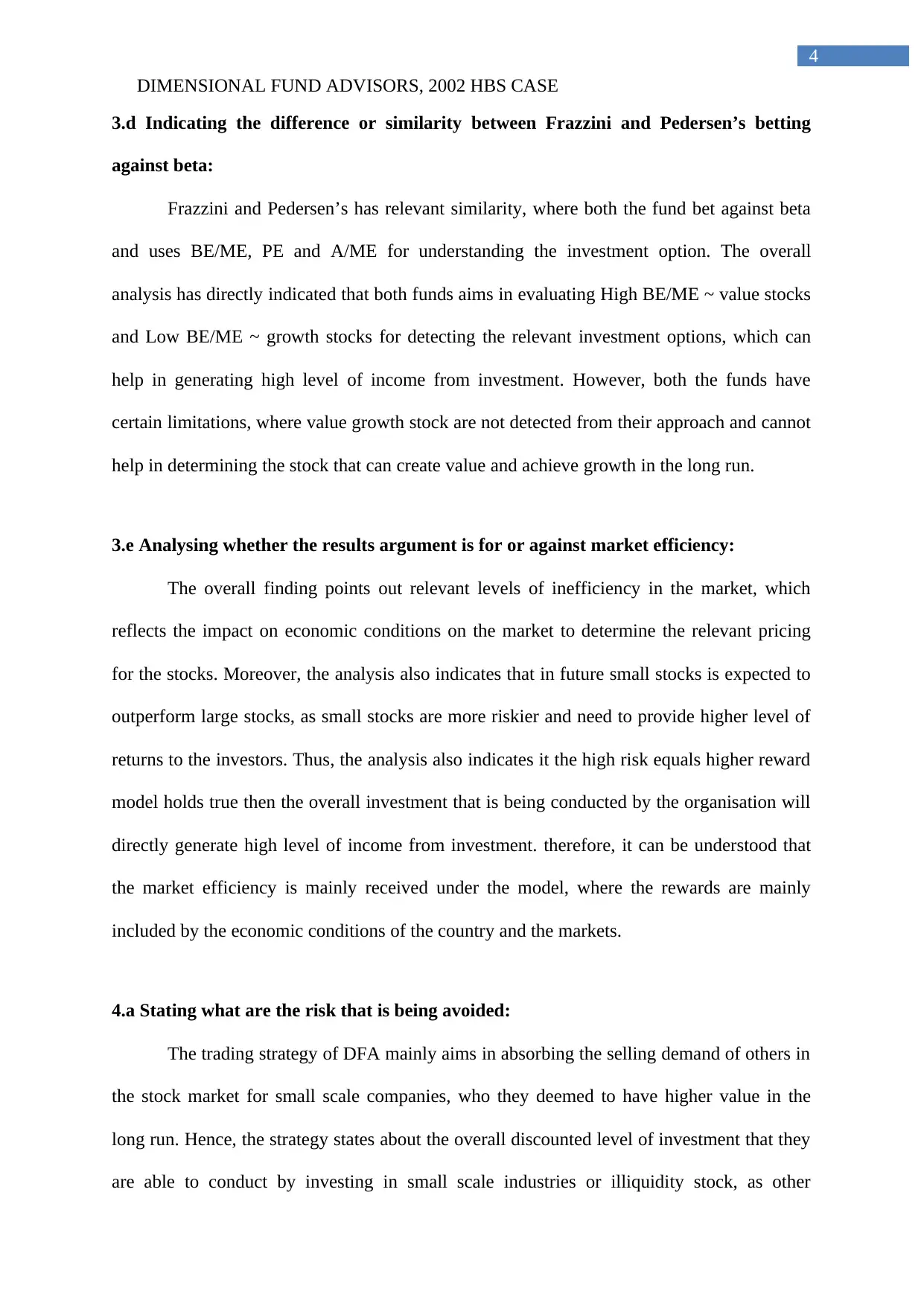
DIMENSIONAL FUND ADVISORS, 2002 HBS CASE
4
3.d Indicating the difference or similarity between Frazzini and Pedersen’s betting
against beta:
Frazzini and Pedersen’s has relevant similarity, where both the fund bet against beta
and uses BE/ME, PE and A/ME for understanding the investment option. The overall
analysis has directly indicated that both funds aims in evaluating High BE/ME ~ value stocks
and Low BE/ME ~ growth stocks for detecting the relevant investment options, which can
help in generating high level of income from investment. However, both the funds have
certain limitations, where value growth stock are not detected from their approach and cannot
help in determining the stock that can create value and achieve growth in the long run.
3.e Analysing whether the results argument is for or against market efficiency:
The overall finding points out relevant levels of inefficiency in the market, which
reflects the impact on economic conditions on the market to determine the relevant pricing
for the stocks. Moreover, the analysis also indicates that in future small stocks is expected to
outperform large stocks, as small stocks are more riskier and need to provide higher level of
returns to the investors. Thus, the analysis also indicates it the high risk equals higher reward
model holds true then the overall investment that is being conducted by the organisation will
directly generate high level of income from investment. therefore, it can be understood that
the market efficiency is mainly received under the model, where the rewards are mainly
included by the economic conditions of the country and the markets.
4.a Stating what are the risk that is being avoided:
The trading strategy of DFA mainly aims in absorbing the selling demand of others in
the stock market for small scale companies, who they deemed to have higher value in the
long run. Hence, the strategy states about the overall discounted level of investment that they
are able to conduct by investing in small scale industries or illiquidity stock, as other
4
3.d Indicating the difference or similarity between Frazzini and Pedersen’s betting
against beta:
Frazzini and Pedersen’s has relevant similarity, where both the fund bet against beta
and uses BE/ME, PE and A/ME for understanding the investment option. The overall
analysis has directly indicated that both funds aims in evaluating High BE/ME ~ value stocks
and Low BE/ME ~ growth stocks for detecting the relevant investment options, which can
help in generating high level of income from investment. However, both the funds have
certain limitations, where value growth stock are not detected from their approach and cannot
help in determining the stock that can create value and achieve growth in the long run.
3.e Analysing whether the results argument is for or against market efficiency:
The overall finding points out relevant levels of inefficiency in the market, which
reflects the impact on economic conditions on the market to determine the relevant pricing
for the stocks. Moreover, the analysis also indicates that in future small stocks is expected to
outperform large stocks, as small stocks are more riskier and need to provide higher level of
returns to the investors. Thus, the analysis also indicates it the high risk equals higher reward
model holds true then the overall investment that is being conducted by the organisation will
directly generate high level of income from investment. therefore, it can be understood that
the market efficiency is mainly received under the model, where the rewards are mainly
included by the economic conditions of the country and the markets.
4.a Stating what are the risk that is being avoided:
The trading strategy of DFA mainly aims in absorbing the selling demand of others in
the stock market for small scale companies, who they deemed to have higher value in the
long run. Hence, the strategy states about the overall discounted level of investment that they
are able to conduct by investing in small scale industries or illiquidity stock, as other
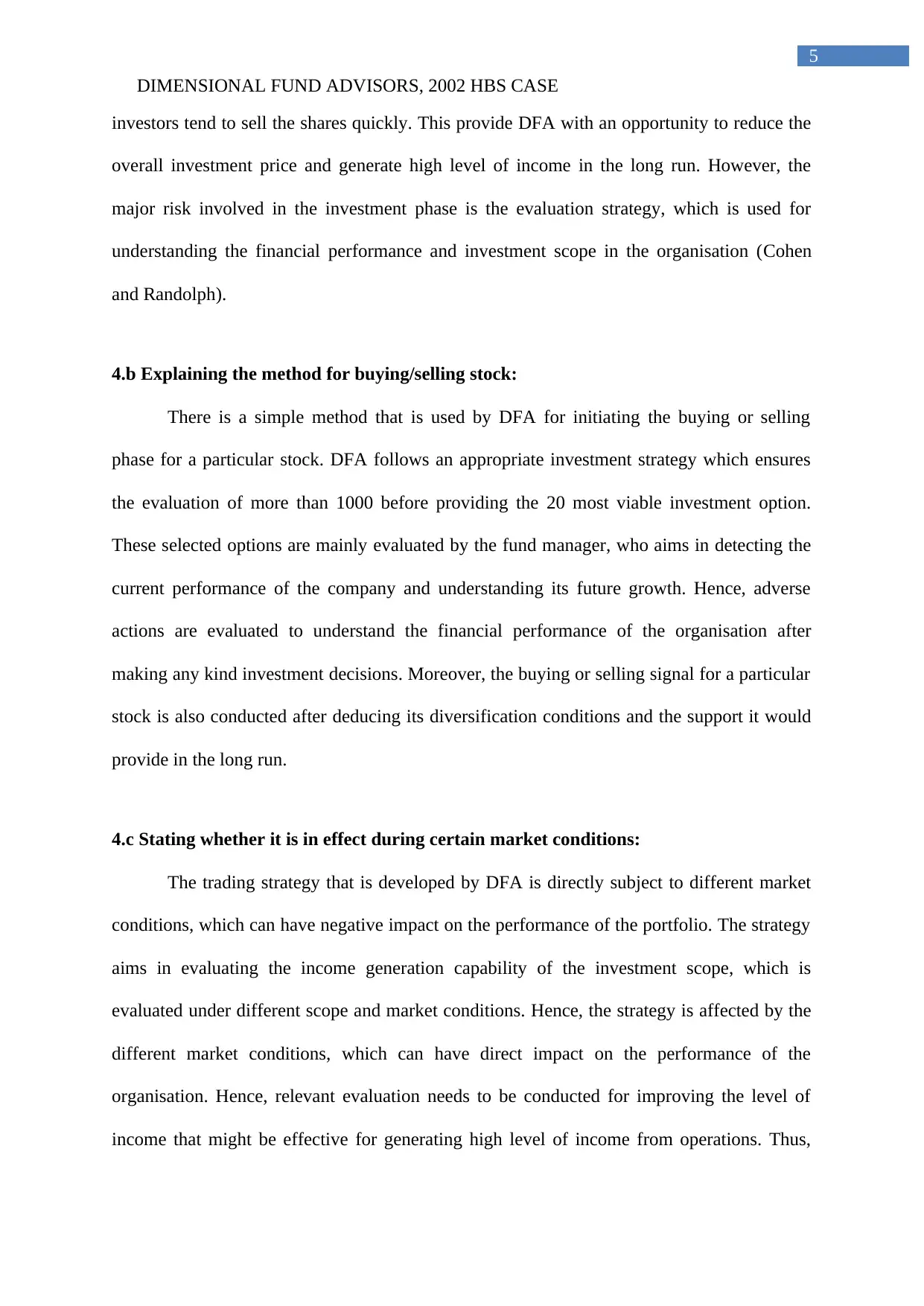
DIMENSIONAL FUND ADVISORS, 2002 HBS CASE
5
investors tend to sell the shares quickly. This provide DFA with an opportunity to reduce the
overall investment price and generate high level of income in the long run. However, the
major risk involved in the investment phase is the evaluation strategy, which is used for
understanding the financial performance and investment scope in the organisation (Cohen
and Randolph).
4.b Explaining the method for buying/selling stock:
There is a simple method that is used by DFA for initiating the buying or selling
phase for a particular stock. DFA follows an appropriate investment strategy which ensures
the evaluation of more than 1000 before providing the 20 most viable investment option.
These selected options are mainly evaluated by the fund manager, who aims in detecting the
current performance of the company and understanding its future growth. Hence, adverse
actions are evaluated to understand the financial performance of the organisation after
making any kind investment decisions. Moreover, the buying or selling signal for a particular
stock is also conducted after deducing its diversification conditions and the support it would
provide in the long run.
4.c Stating whether it is in effect during certain market conditions:
The trading strategy that is developed by DFA is directly subject to different market
conditions, which can have negative impact on the performance of the portfolio. The strategy
aims in evaluating the income generation capability of the investment scope, which is
evaluated under different scope and market conditions. Hence, the strategy is affected by the
different market conditions, which can have direct impact on the performance of the
organisation. Hence, relevant evaluation needs to be conducted for improving the level of
income that might be effective for generating high level of income from operations. Thus,
5
investors tend to sell the shares quickly. This provide DFA with an opportunity to reduce the
overall investment price and generate high level of income in the long run. However, the
major risk involved in the investment phase is the evaluation strategy, which is used for
understanding the financial performance and investment scope in the organisation (Cohen
and Randolph).
4.b Explaining the method for buying/selling stock:
There is a simple method that is used by DFA for initiating the buying or selling
phase for a particular stock. DFA follows an appropriate investment strategy which ensures
the evaluation of more than 1000 before providing the 20 most viable investment option.
These selected options are mainly evaluated by the fund manager, who aims in detecting the
current performance of the company and understanding its future growth. Hence, adverse
actions are evaluated to understand the financial performance of the organisation after
making any kind investment decisions. Moreover, the buying or selling signal for a particular
stock is also conducted after deducing its diversification conditions and the support it would
provide in the long run.
4.c Stating whether it is in effect during certain market conditions:
The trading strategy that is developed by DFA is directly subject to different market
conditions, which can have negative impact on the performance of the portfolio. The strategy
aims in evaluating the income generation capability of the investment scope, which is
evaluated under different scope and market conditions. Hence, the strategy is affected by the
different market conditions, which can have direct impact on the performance of the
organisation. Hence, relevant evaluation needs to be conducted for improving the level of
income that might be effective for generating high level of income from operations. Thus,
⊘ This is a preview!⊘
Do you want full access?
Subscribe today to unlock all pages.

Trusted by 1+ million students worldwide
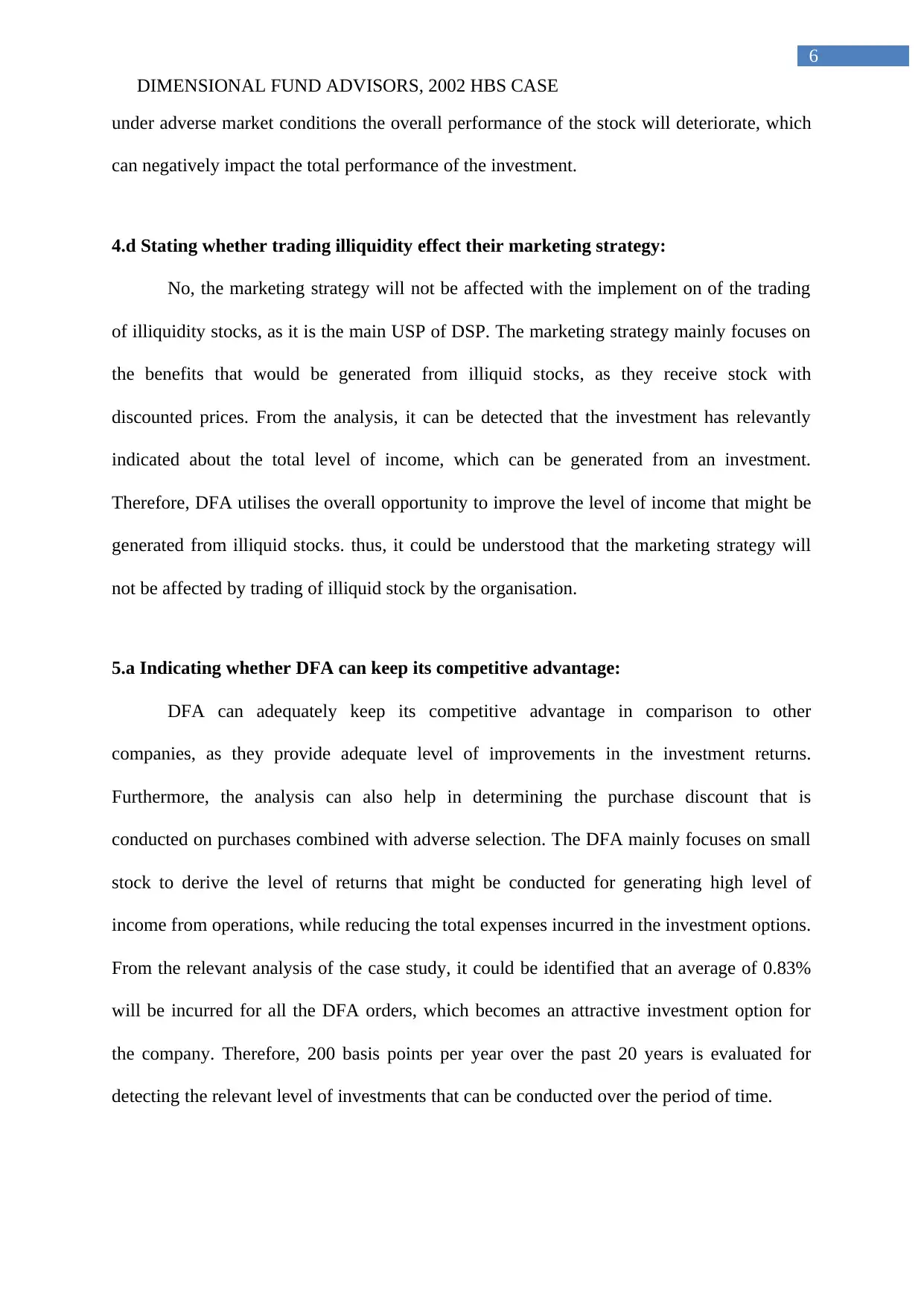
DIMENSIONAL FUND ADVISORS, 2002 HBS CASE
6
under adverse market conditions the overall performance of the stock will deteriorate, which
can negatively impact the total performance of the investment.
4.d Stating whether trading illiquidity effect their marketing strategy:
No, the marketing strategy will not be affected with the implement on of the trading
of illiquidity stocks, as it is the main USP of DSP. The marketing strategy mainly focuses on
the benefits that would be generated from illiquid stocks, as they receive stock with
discounted prices. From the analysis, it can be detected that the investment has relevantly
indicated about the total level of income, which can be generated from an investment.
Therefore, DFA utilises the overall opportunity to improve the level of income that might be
generated from illiquid stocks. thus, it could be understood that the marketing strategy will
not be affected by trading of illiquid stock by the organisation.
5.a Indicating whether DFA can keep its competitive advantage:
DFA can adequately keep its competitive advantage in comparison to other
companies, as they provide adequate level of improvements in the investment returns.
Furthermore, the analysis can also help in determining the purchase discount that is
conducted on purchases combined with adverse selection. The DFA mainly focuses on small
stock to derive the level of returns that might be conducted for generating high level of
income from operations, while reducing the total expenses incurred in the investment options.
From the relevant analysis of the case study, it could be identified that an average of 0.83%
will be incurred for all the DFA orders, which becomes an attractive investment option for
the company. Therefore, 200 basis points per year over the past 20 years is evaluated for
detecting the relevant level of investments that can be conducted over the period of time.
6
under adverse market conditions the overall performance of the stock will deteriorate, which
can negatively impact the total performance of the investment.
4.d Stating whether trading illiquidity effect their marketing strategy:
No, the marketing strategy will not be affected with the implement on of the trading
of illiquidity stocks, as it is the main USP of DSP. The marketing strategy mainly focuses on
the benefits that would be generated from illiquid stocks, as they receive stock with
discounted prices. From the analysis, it can be detected that the investment has relevantly
indicated about the total level of income, which can be generated from an investment.
Therefore, DFA utilises the overall opportunity to improve the level of income that might be
generated from illiquid stocks. thus, it could be understood that the marketing strategy will
not be affected by trading of illiquid stock by the organisation.
5.a Indicating whether DFA can keep its competitive advantage:
DFA can adequately keep its competitive advantage in comparison to other
companies, as they provide adequate level of improvements in the investment returns.
Furthermore, the analysis can also help in determining the purchase discount that is
conducted on purchases combined with adverse selection. The DFA mainly focuses on small
stock to derive the level of returns that might be conducted for generating high level of
income from operations, while reducing the total expenses incurred in the investment options.
From the relevant analysis of the case study, it could be identified that an average of 0.83%
will be incurred for all the DFA orders, which becomes an attractive investment option for
the company. Therefore, 200 basis points per year over the past 20 years is evaluated for
detecting the relevant level of investments that can be conducted over the period of time.
Paraphrase This Document
Need a fresh take? Get an instant paraphrase of this document with our AI Paraphraser
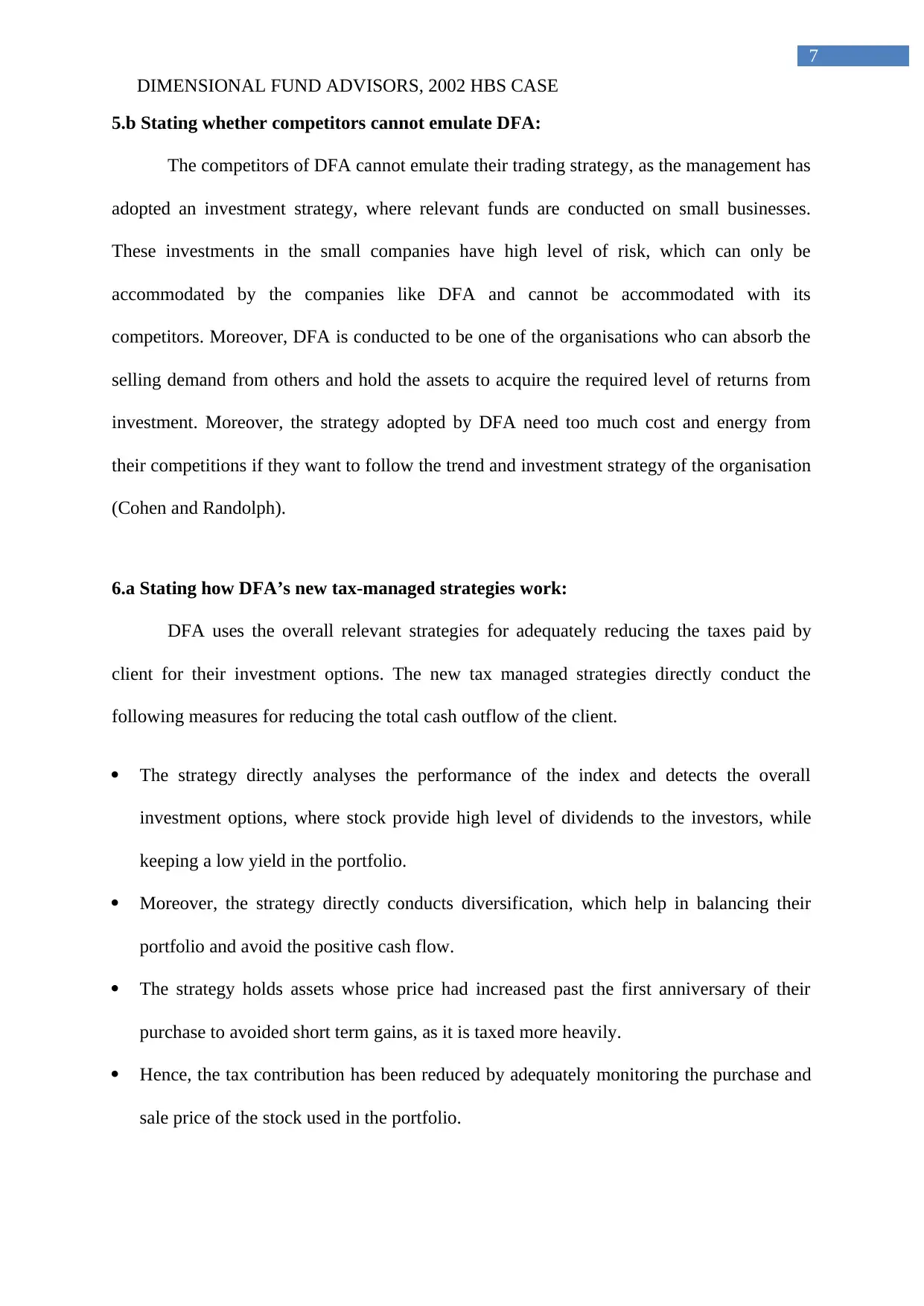
DIMENSIONAL FUND ADVISORS, 2002 HBS CASE
7
5.b Stating whether competitors cannot emulate DFA:
The competitors of DFA cannot emulate their trading strategy, as the management has
adopted an investment strategy, where relevant funds are conducted on small businesses.
These investments in the small companies have high level of risk, which can only be
accommodated by the companies like DFA and cannot be accommodated with its
competitors. Moreover, DFA is conducted to be one of the organisations who can absorb the
selling demand from others and hold the assets to acquire the required level of returns from
investment. Moreover, the strategy adopted by DFA need too much cost and energy from
their competitions if they want to follow the trend and investment strategy of the organisation
(Cohen and Randolph).
6.a Stating how DFA’s new tax-managed strategies work:
DFA uses the overall relevant strategies for adequately reducing the taxes paid by
client for their investment options. The new tax managed strategies directly conduct the
following measures for reducing the total cash outflow of the client.
The strategy directly analyses the performance of the index and detects the overall
investment options, where stock provide high level of dividends to the investors, while
keeping a low yield in the portfolio.
Moreover, the strategy directly conducts diversification, which help in balancing their
portfolio and avoid the positive cash flow.
The strategy holds assets whose price had increased past the first anniversary of their
purchase to avoided short term gains, as it is taxed more heavily.
Hence, the tax contribution has been reduced by adequately monitoring the purchase and
sale price of the stock used in the portfolio.
7
5.b Stating whether competitors cannot emulate DFA:
The competitors of DFA cannot emulate their trading strategy, as the management has
adopted an investment strategy, where relevant funds are conducted on small businesses.
These investments in the small companies have high level of risk, which can only be
accommodated by the companies like DFA and cannot be accommodated with its
competitors. Moreover, DFA is conducted to be one of the organisations who can absorb the
selling demand from others and hold the assets to acquire the required level of returns from
investment. Moreover, the strategy adopted by DFA need too much cost and energy from
their competitions if they want to follow the trend and investment strategy of the organisation
(Cohen and Randolph).
6.a Stating how DFA’s new tax-managed strategies work:
DFA uses the overall relevant strategies for adequately reducing the taxes paid by
client for their investment options. The new tax managed strategies directly conduct the
following measures for reducing the total cash outflow of the client.
The strategy directly analyses the performance of the index and detects the overall
investment options, where stock provide high level of dividends to the investors, while
keeping a low yield in the portfolio.
Moreover, the strategy directly conducts diversification, which help in balancing their
portfolio and avoid the positive cash flow.
The strategy holds assets whose price had increased past the first anniversary of their
purchase to avoided short term gains, as it is taxed more heavily.
Hence, the tax contribution has been reduced by adequately monitoring the purchase and
sale price of the stock used in the portfolio.
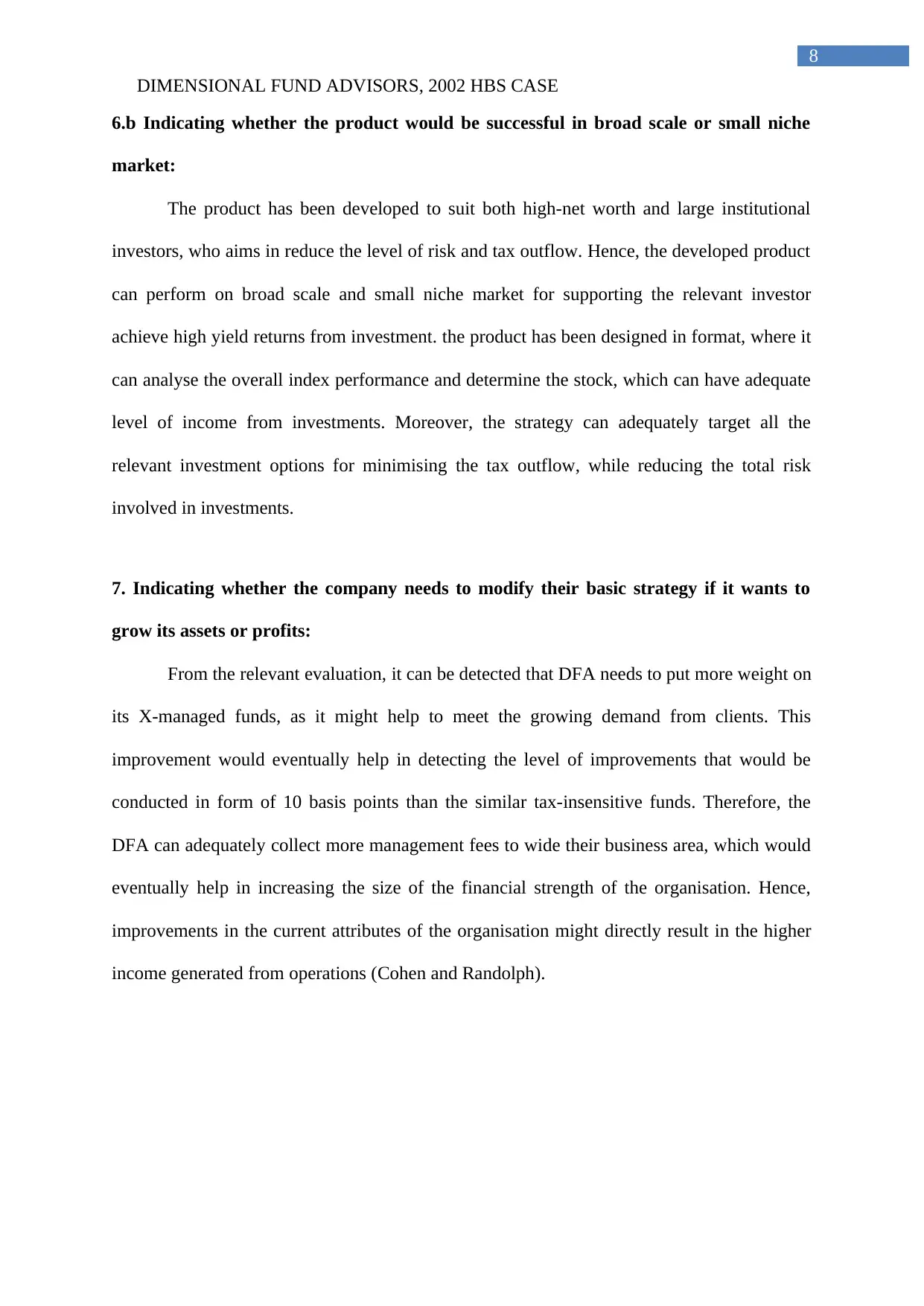
DIMENSIONAL FUND ADVISORS, 2002 HBS CASE
8
6.b Indicating whether the product would be successful in broad scale or small niche
market:
The product has been developed to suit both high-net worth and large institutional
investors, who aims in reduce the level of risk and tax outflow. Hence, the developed product
can perform on broad scale and small niche market for supporting the relevant investor
achieve high yield returns from investment. the product has been designed in format, where it
can analyse the overall index performance and determine the stock, which can have adequate
level of income from investments. Moreover, the strategy can adequately target all the
relevant investment options for minimising the tax outflow, while reducing the total risk
involved in investments.
7. Indicating whether the company needs to modify their basic strategy if it wants to
grow its assets or profits:
From the relevant evaluation, it can be detected that DFA needs to put more weight on
its X-managed funds, as it might help to meet the growing demand from clients. This
improvement would eventually help in detecting the level of improvements that would be
conducted in form of 10 basis points than the similar tax-insensitive funds. Therefore, the
DFA can adequately collect more management fees to wide their business area, which would
eventually help in increasing the size of the financial strength of the organisation. Hence,
improvements in the current attributes of the organisation might directly result in the higher
income generated from operations (Cohen and Randolph).
8
6.b Indicating whether the product would be successful in broad scale or small niche
market:
The product has been developed to suit both high-net worth and large institutional
investors, who aims in reduce the level of risk and tax outflow. Hence, the developed product
can perform on broad scale and small niche market for supporting the relevant investor
achieve high yield returns from investment. the product has been designed in format, where it
can analyse the overall index performance and determine the stock, which can have adequate
level of income from investments. Moreover, the strategy can adequately target all the
relevant investment options for minimising the tax outflow, while reducing the total risk
involved in investments.
7. Indicating whether the company needs to modify their basic strategy if it wants to
grow its assets or profits:
From the relevant evaluation, it can be detected that DFA needs to put more weight on
its X-managed funds, as it might help to meet the growing demand from clients. This
improvement would eventually help in detecting the level of improvements that would be
conducted in form of 10 basis points than the similar tax-insensitive funds. Therefore, the
DFA can adequately collect more management fees to wide their business area, which would
eventually help in increasing the size of the financial strength of the organisation. Hence,
improvements in the current attributes of the organisation might directly result in the higher
income generated from operations (Cohen and Randolph).
⊘ This is a preview!⊘
Do you want full access?
Subscribe today to unlock all pages.

Trusted by 1+ million students worldwide
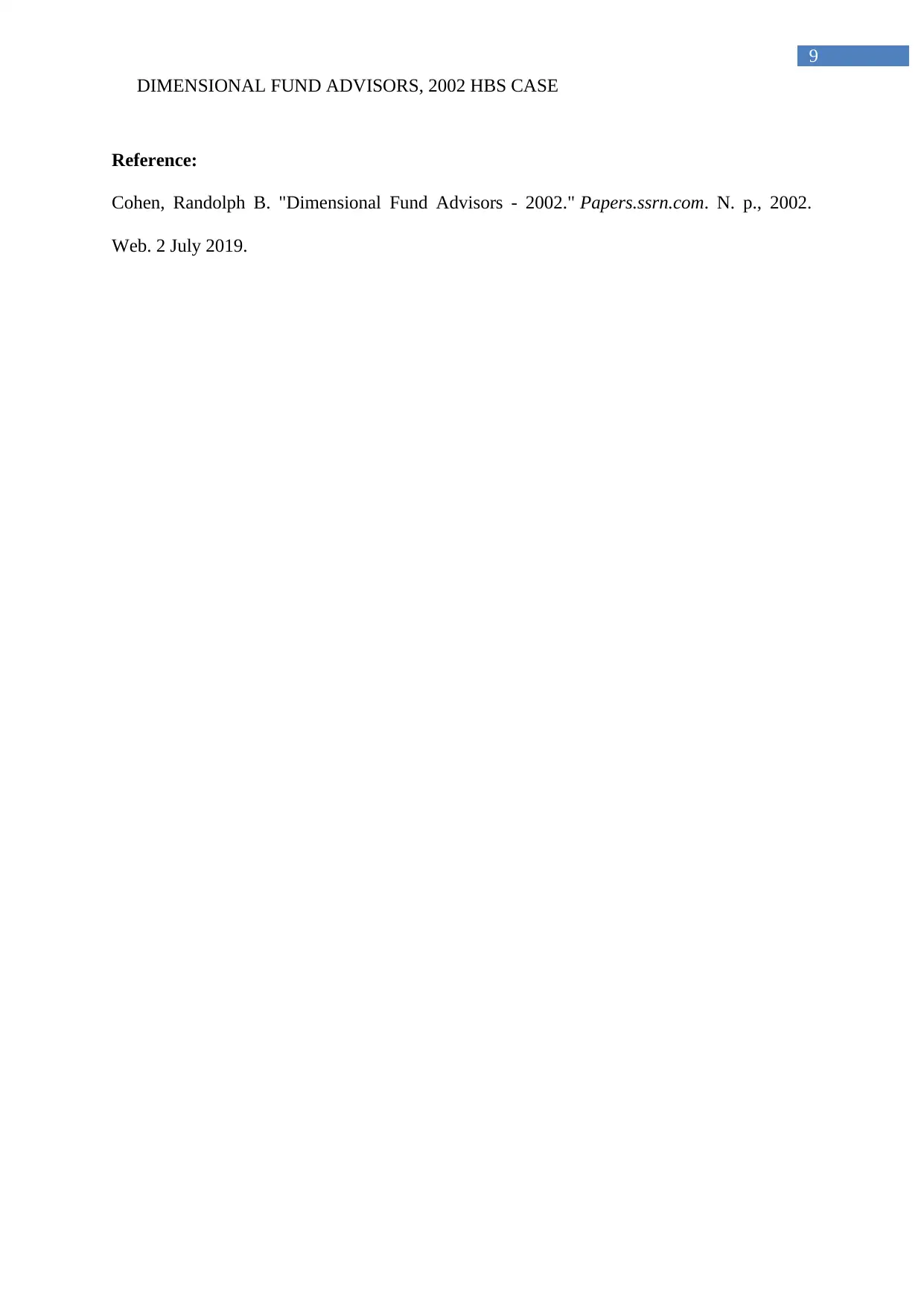
DIMENSIONAL FUND ADVISORS, 2002 HBS CASE
9
Reference:
Cohen, Randolph B. "Dimensional Fund Advisors - 2002." Papers.ssrn.com. N. p., 2002.
Web. 2 July 2019.
9
Reference:
Cohen, Randolph B. "Dimensional Fund Advisors - 2002." Papers.ssrn.com. N. p., 2002.
Web. 2 July 2019.
1 out of 10
Related Documents
Your All-in-One AI-Powered Toolkit for Academic Success.
+13062052269
info@desklib.com
Available 24*7 on WhatsApp / Email
![[object Object]](/_next/static/media/star-bottom.7253800d.svg)
Unlock your academic potential
Copyright © 2020–2025 A2Z Services. All Rights Reserved. Developed and managed by ZUCOL.





